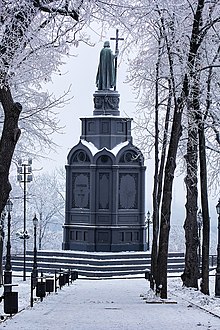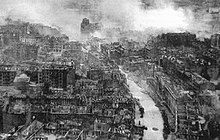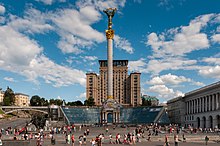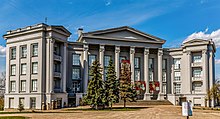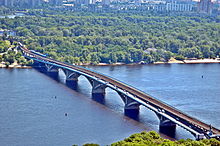Kiev
| Kiev | ||
| Київ / Kyiv | ||

|

|
|
| Basic data | ||
|---|---|---|
| Oblast : | Kiev city | |
| Rajon : | District-free city | |
| Height : | 179 m | |
| Area : | 847.66 km² | |
| Residents : | 2,964,448 (November 1, 2020) | |
| Population density : | 3,497 inhabitants per km² | |
| Postcodes : | 01xxx-04xxx | |
| Area code : | +380 44 | |
| Geographic location : | 50 ° 27 ′ N , 30 ° 30 ′ E | |
| KOATUU : | 8000000000 | |
| Administrative structure : | 10 Rajons | |
| Mayor : | Vitali Klitschko | |
| Address: | Вул. Хрещатик 36 01 044 м. Київ |
|
| Website : | https://kyivcity.gov.ua/ | |
| Statistical information | ||
|
|
||
Kiev ( Ukrainian Київ Kyjiw [ ˈkɪjɪu̯ ]; Russian Киев Kijew [ ˈkʲi (ɪ̯) ɪf ]) is the capital and largest city of Ukraine and the administrative seat of Kiev Oblast and Kiev-Svyatoshyn Raion . It lies on the Dnepr, which is navigable for smaller seagoing vessels up to this point, and has almost 3 million inhabitants on an area of 847.66 km². The agglomeration has more than four million inhabitants.
Kiev is considered an important educational and industrial location and is also the country's most important transport hub. Due to its historical importance as the center of the Kievan Rus , the city has often been nicknamed the mother of all Russian cities since the same name in the Nestor Chronicles . Because of the many churches and monasteries and its importance for Orthodox Christianity, Kiev has also been referred to as the Jerusalem of the East since the Middle Ages . After the end of World War II , Kiev received the award of a Hero City . The asteroid (2171) Kiev , discovered by TM Smirnova at the Crimean Observatory on August 28, 1973 , was named after the city, as was a peninsula in Antarctica in 2010 .
population
According to the official census in Ukraine in 2001, about 82.2% Ukrainians and 13.1% Russians lived in Kiev . There are also small minorities of other nationalities and ethnic groups ( Belarusians , Poles , Armenians , Jews and others).
| nationality | Residents | 1989 (%) | 2001 (%) | Change (%) |
|---|---|---|---|---|
| Ukrainians | 2,110,800 | 72.5 | 82.2 | + 13.3% |
| Russians | 337,300 | 20.9 | 13.1 | −37.1% |
| Jews | 17,900 | 3.9 | 0.7 | −82.1% |
| Belarusians | 16,500 | 1.0 | 0.6 | −34.5% |
| Poland | 6,900 | 0.4 | 0.3 | −33.7% |
| Armenians | 4,900 | 0.2 | 0.2 | + 8.9% |
Demographic development
Population development over the past thousand years
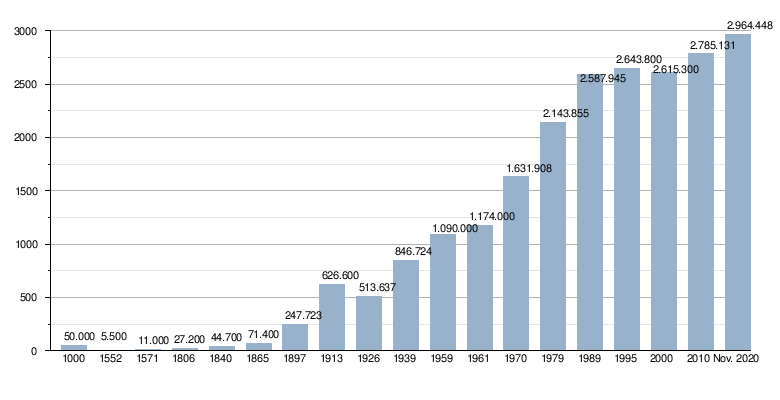
Sources: 1897 :, 1926. 1939, 1961 :, 1970 :, 1979, 1989: 1995-2010: 2020:
language
The language situation in Kiev has changed radically several times in the course of history. Kiev is a bilingual city where both Ukrainian and Russian are spoken.
At the time of the Kievan Rus, Old East Slavic was spoken in the city , from which modern Ukrainian (as well as Russian) developed. Under the influence of Poland-Lithuania , the Polish language found its way into Kiev by the 16th century at the latest and was still spoken by a large part of the city's population in the early 19th century. As early as the 17th century, however, Kiev became part of the Russian Empire , at the same time Russian was introduced by the state, which gradually advanced to become the dominant language of Kiev. With the exception of a few brief interruptions, Russian was preferred to Ukrainian in the Soviet Union and Ukrainian was increasingly displaced. In the 1980s, Kiev was largely Russian-speaking.
After the collapse of the Soviet Union and since the independence of Ukraine, however, a tendency towards Ukrainian can be seen again.
The result of the 2001 census:
| mother tongue | 2001 (%) |
|---|---|
| Ukrainian | 72.1 |
| Russian | 25.4 |
| Other | 2.5 |
In a public survey in 2005, 64% of Kiev residents named Ukrainian and 34% Russian as their mother tongue. However, these figures are only partially meaningful and only partially provide information about the language preferred in everyday life, as many Ukrainians simply understand the term mother tongue to be their national language and not their mother tongue in the linguistic sense.
A study from the same year, with a different question, found different figures for Kiev. 41.2% of the respondents stated that they use both Russian and Ukrainian in everyday life, 39.9% of the respondents only used Russian and 18.1% generally only spoke Ukrainian.
religion
The patron saint of Kiev, also shown in the city arms, is the Archangel Michael .
Kiev is the seat of the Metropolitan of the Ukrainian Orthodox Church and a Russian Orthodox Metropolitan. The Kiev Cathedral of St. Sophia is the second oldest East Slavic cathedral after the Transfiguration Cathedral in Chernihiv .
In 2005, the Grand Archbishop of the Greek Catholic Church united with the Roman Catholic Church moved his seat from Lviv to Kiev.
Since 1991 there is again an Evangelical Lutheran congregation in the Ukrainian capital. On November 29, 1998, she received her St. Catherine's Church back from the state . The congregation, which belongs to the German Evangelical Lutheran Church of Ukraine , consists mainly of Germans from Russia , but also from the staff of the German-speaking embassies with their families.
There is a Jewish minority in Kiev . The Islamic Institute and the Spiritual Administration of Muslims in Ukraine are also located there .
geography

topography
The city lies on both banks of the Dnieper , which flows south towards the Black Sea . The right, western bank of the river with the historic city center is characterized by numerous, originally wooded, small hills of the Dnepr highlands . Constant ups and downs and chestnut trees are typical for downtown Kiev. The hills here drop steeply to the river. Further to the north - in the Podil district - there is a flat and wide, built-up strip of banks.
The left, eastern bank of the river was not opened until the 20th century. In contrast to the opposite side, it is flat and characterized by forest steppe . There are also numerous lakes here. Some small tributaries, such as the Lybid , flow into the Dnepr within the urban area. This branches out into numerous watercourses in the urban area. The trukhaniv island and other larger islands that were hardly built to serve as recreation areas.
climate
Kiev is located in the northern part of Ukraine. Summers are warm with average temperatures of 19.3 to 25.3 ° C in June, July and August. The coldest months are December, January and February with average temperatures of −4.6 to −1.1 ° C. On July 31, 1936, the record high temperature of 39.4 ° C was measured. The lowest recorded temperature was −32.2 ° C on February 9, 1929. Kiev was usually covered with snow from mid-November to the end of March, although this has been falling in recent years.
| Kiev | ||||||||||||||||||||||||||||||||||||||||||||||||
|---|---|---|---|---|---|---|---|---|---|---|---|---|---|---|---|---|---|---|---|---|---|---|---|---|---|---|---|---|---|---|---|---|---|---|---|---|---|---|---|---|---|---|---|---|---|---|---|---|
| Climate diagram | ||||||||||||||||||||||||||||||||||||||||||||||||
| ||||||||||||||||||||||||||||||||||||||||||||||||
|
Average monthly temperatures and rainfall for Kiev
Source: Ukrainian Hydrometeorological Center, data: 1961–1990; wetterkontor.de
|
|||||||||||||||||||||||||||||||||||||||||||||||||||||||||||||||||||||||||||||||||||||||||||||||||||||||||||||||||||||||||||||||||||||||||||||||||||||||||||||||||||||
story
The oldest settlement finds in today's urban area come from the Magdalenian culture and are located at Kiev-Kyrill-Wohnplatz in the Podil district .
founding
According Nestorchronik Kiev was by the three brothers Kyi, Shchek and Khoryv and their sister Lybid from the tribe of Poljanen established who built on three hills villages. They built another fortress, which they named after their eldest brother (“Kiev” = “City of Kyj”, Ukrainian: Kyiv ). This is said to have happened no later than the beginning of the 6th century, since the name of the East Slavic prince Kyj was mentioned in Byzantine chronicles at this time .
According to some western, but also some Ukrainian historians (Kevin Alan Brook, Omeljan Pritsak ), Kiev is said to have been founded in 840 by Muslim mercenaries in the Khazarian army as a Khazarian garrison in Polyjan land, the name of the city being, like these mercenaries, of Eastern Iranian origin. Slavs and Varangians are said to have conquered the city only around 930 . This theory, however, contradicts chronicles of Varangian rulers from this period.
Medieval heyday
The city had a strategic location on the trade route from the Baltic Sea to the Black Sea, the route from the Varangians to the Greeks . In the middle of the 9th century it was ruled by the Warsaw princes Askold and Dir before they were killed by Rurik's general Oleg von Novgorod in 882. This united the entire domain of the Varangians ( Rus ) along the trade route and made Kiev the princely residence of the Rus . In 988 the Grand Duke Vladimir I initiated the conversion of the hitherto pagan Rus to Orthodox Christianity of Byzantine style. This act was marked by a mass baptism of the Kiev population in the Dnieper and the fall of the old idols into the river. Under Vladimir's son Yaroslav the Wise , Kiev was greatly expanded. In addition to numerous new churches and monasteries, the first East Slavic library was founded. The active marriage policy and the expansion of the city made her known throughout Europe. With this, Kiev reached the height of its development in the 11th and 12th centuries and became one of the largest cities in Europe .
Decline
After Yaroslav's death, battles for succession began, which had a negative impact on the city and led to repeated conquests and destruction. So Kiev was conquered in 1169 by Prince Andrei Bogolyubski of Vladimir-Suzdal . Instead of settling there, he took the title of Grand Duke, which had previously been bound to Kiev, with him north to his residence near Vladimir . With that, the disintegration of the Kiev Empire continued. The fact that Kiev was no longer the seat of the Grand Duke did not mean the downfall of the city, as the metropolitans of the Russian Orthodox Church resided in Kiev until the end of the 13th century.
In 1240 Kiev was conquered by the troops of Batu Khan in the course of the Mongol invasion of the Rus after a siege of almost ten weeks . Almost all residents were killed and almost all buildings burned down. It was reported that there were only 200 houses left of the large and densely populated city. After the city was destroyed again, the Orthodox metropolitan left Kiev in 1299 and moved to Vladimir. In 1320/1365 Kiev came to Lithuania as a result of the Battle of the Irpen and the Battle of the Blue Water . Initially, the Principality of Kiev , which originated from the time of the Kievan Rus, enjoyed a certain degree of autonomy within Lithuania. Its rulers, however, feared efforts to separate and dissolved the principality. In 1482 Kiev was devastated by the Crimean Khan Meñli I. Giray . The city became a Polish-Lithuanian provincial capital ( Kiev Voivodeship ) in 1569 . After the church union of Brest in 1596 , Kiev became the scene of a denominational struggle between the Catholics and the Uniates on the one hand and the Orthodox on the other, who rejected an imposed submission to the Pope. In 1632, the Kyiv Mohyla College was established as the first university in the East Slavic region.
Russian Empire
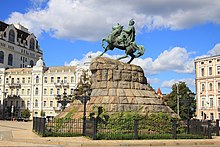
After the Khmelnytskyi Uprising , which began in 1648 , Kiev became the capital of the Hetmanate of the Zaporog Cossacks . In 1654 they submitted to the Moscow Tsar in the Pereyaslav Agreement . Under the rule of the Cossack hetman Ivan Masepa , numerous important buildings were renovated and schools were founded. The Kiev Pechersk Lavra , St. Sophia Cathedral and St. Michael's Monastery received their current appearance in the style of the Ukrainian Baroque . The baroque St. Andrew's Church and St. Mary's Palace were built under Empress Elisabeth . Urban development suffered a setback in the major fire in the Kiev district of Podil in 1811.

Emperor Nicholas I in particular , who affectionately called Kiev the Jerusalem of Russian soil , did a lot to ensure that Kiev was developed into an important trade, transport and industrial center of the Russian Empire . Among other things, he founded the St. Vladimir University , today's National Taras Shevchenko University of Kiev, and initiated the construction of the massive Nicholas Chain Bridge over the Dnieper. In 1888 the city celebrated the 900th anniversary of the Christianization of Rus with great pomp . The construction of the Byzantine style St. Vladimir's Cathedral was dedicated to this anniversary .
As the first city in the Russian Empire, Kiev received an electric tram in 1892 . Around 1900, at the end of Mayor Stepan Solskyj's term of office , the city had a population of around 250,000, and the number of inhabitants continued to grow massively over the next few years. In 1911, the Russian Prime Minister Pyotr Stolypin was shot by an anarchist in Kiev . After the Russian Revolution and during the German occupation at the end of the First World War , the short-lived Ukrainian nation- states Ukrainian People's Republic and Ukrainian State emerged here .
Soviet era
From 1920 Kiev was Soviet and initially only the administrative seat of the Okrug Kiev and the Kiev Oblast . On January 19, 1934, the city became the capital of the Ukrainian Soviet Socialist Republic ( SSR ) instead of Kharkov, and the government moved here on June 24, 1934. During the 1930s, many historical buildings in Kiev were demolished by the Soviet authorities. In Bykivnia , a forest to the east of the city, around 130,000 people were murdered during Stalinism .
Before the German attack on the Soviet Union , the city counted 350,000 Jews , most of whom were able to flee in time for the invasion of the Wehrmacht , so that when the invasion of September 1941 only 30% of the Jews lived in the city (approx. 100,000 Jews). During the German occupation in the German-Soviet War , from September 19, 1941 to November 6, 1943, 120,000 to 160,000 Soviet prisoners of war and civilians (mainly Jews) were murdered in Kiev by the occupiers. More than 33,000 Jews died in the massacre in Babi Yar near Kiev on September 29 and 30, 1941. In 1942, the Syrez concentration camp was built on the northern edge of the city .
Great damage took the city shortly after the battle of Kiev by a devastating fire, which was released on September 24, 1941 remotely ignited Soviet explosive devices and only on September 29, using the German and local firefighters by blowing up firebreaks could be deleted. In a second battle for Kiev , the city was liberated by the Red Army on November 6, 1943 after 778 days of German occupation. In the city there was (until 1954) the POW camp 62 for German POWs of the Second World War, plus the POW Hospital 3201 . There were various cemeteries for prisoners of war, the largest north of the city with about 20,000 dead.
In the post-war period, the city was rapidly rebuilt and continued its rapid population growth. In particular, the central Khreshchatyk Street and today's Majdan Nesaleschnosti (then Kalinin Square , later October Revolution Square ) were monumentally expanded and rebuilt. The Kiev metro was based on the Moscow model . To commemorate the victory in the Great Patriotic War, the huge Mother Homeland statue was built on the high right-hand side of the Dnieper .
In 1982 the celebrations of the 1500th anniversary of Kiev took place. In 1986, the city was from Chernobyl - GAU badly hit.
After the urban area was expanded by 110.7 hectares on April 4, 1978 and by 624.3 hectares on March 5, 1982, the last urban area expansion so far took place on August 26, 1988 with the incorporation of 3440 hectares of the Kiev region.
Kiev after Ukrainian independence in 1991
Kiev has been the capital of independent Ukraine since 1991. As a result, numerous buildings that had been destroyed during the Stalinist period were rebuilt, such as the Michael's monastery and the Church of the Nativity of Christ in the Podil district . From November 2004 the city center became the scene of the mass protests against the counterfeiting in the 2004 presidential election , which ultimately led to the Orange Revolution . From December 2013 to the end of February 2014, the city was the scene of the “ Euromaidan ”, a protest movement against the Ukrainian government, which led to its overthrow. After Russia annexed Crimea , it gave up its resistance to an OSCE observer mission in Ukraine and on March 21, 2014 observers were deployed to the city. On October 9, 2019, 19 municipalities founded the Kiev agglomeration ( Київська агломерація ) in order to accelerate the socio-economic development and the expansion of the infrastructure of the metropolitan area and to increase the investment attractiveness of the greater Kiev area with more than 4 million inhabitants.
After the first cases of corona virus infections occurred in Kiev at the beginning of the COVID-19 pandemic in Ukraine on March 16, 2020 , the Kiev metro was closed from March 18 to May 25, 2020 by order of the Ukrainian President . As of December 26, 2020, 106,486 people in Kiev had contracted COVID-19 . By that time, 37,130 people had recovered from the disease and 1,829 died in association with it.
Culture and sights
Kiev has a large number of churches, secular buildings and monuments that are well worth seeing . As UNESCO - World Heritage Site was the Sophia Cathedral , the Kiev-Pechersk Lavra and the Dormition Cathedral classified (as part of the cave monastery). There are also some worth seeing synagogues in the city, such as the Brodsky and Podil synagogues . Important streets are the Chreschtschatyk , the large capital boulevard with buildings in the style of socialist classicism and the Andreassteig, known for its cultural life . Not least because of the Orange Revolution and the Euromaidan , the Majdan Nesaleschnosti , the main square of the city with the Hotel Ukrajina and the Ukraine Independence Monument , became famous. Other well-known monuments are the Monument of Friendship of Nations with a monumental arch of 60 meters in diameter and the Mother-Homeland statue . The latter is a 62 meter high colossal statue commemorating the victory in the Great Patriotic War. 27 monuments of leaders from the Soviet era have been removed since 2009 on the instructions of the Kiev city administration in the course of decommunization . In the city there is a stationary circus and a zoo with over 3000 animals in about 400 animal species.
Kiev hosted the Eurovision Song Contest in 2005 and 2017 .
Museums
Kiev is a cultural center of Ukraine and has a large number of museums. Some of the more famous ones include: One Street Museum , Hetman Museum , Ivan Honchar Museum , Lesya Ukrajinka Museum , Mikhail Bulgakov Museum , National Museum of the History of Ukraine in World War II , National Museum Taras Shevchenko , National Historical Museum Museum of Ukraine , National Museum of Art of Ukraine , National Museum of Kiev Art Gallery , Museum of History of Kiev , Museum of Western and Oriental Art Kiev , Museum of Folk Architecture and Customs of Ukraine and the Central Na Rada .
Opera, theater and concert halls
The Taras Shevchenko Opera House is located at Volodymyrska Street 50. The National Academic Theater of Operetta is located on Welyka Wassylkivska Street , the “ National Iwan Franko Theater ” is located on Ivan Franko Square and on Bohdan -Chmelnyzkyj Street 5 is the Russian Drama Theater . The National Philharmonic of Ukraine is located in Khreshchaty Park near European Square . All of these cultural institutions are located in the center of Kiev.
politics
City council
The Kiev City Council ( Київська міська рада ) is the highest political body in the city and performs local political tasks in the “ city with a special status ”. The members of the city council are directly elected for five years by the city's population. The also directly elected mayor of Kiev is the chairman of the city council.
The city council meets in the building of the Kiev city council, built in the 1950s in the style of socialist classicism , on Khreshchatyk No. 36 in the center of Kiev.
mayor
Today Vitali Klitschko, elected on May 25, 2014 with 57.4% of the votes in the first ballot, is mayor and thus chairman of the city council.
In the 2015 local elections in Ukraine , two rounds of mayoral elections were held in Kiev. In the first round Vitali Klitschko reached 40.57% of the vote (353,312 total), Boryslaw Beresa ( Борислав Юхимович Береза ) 8.85% (77,029 total), Oleksandr Omelchenko 8.47% (73,724 total), Volodymyr Bondarenko ( Володимир Дмитрович Бондаренко ) 7.86% (68,460 total) and Serhij Hussowskyj ( Сергій Михайлович Гусовський ) 7.72% (67,197 total). Since none of the candidates received an absolute majority, a second ballot became necessary, which took place on November 15, 2015. In the runoff election Vitali Klitschko was confirmed in the office of mayor with 66.5% compared to 33.5% that Boryslaw Beresa received.
Mayors / mayors of Kiev with their terms in office since Ukrainian independence
- Arnold Nasartschuk ( Арнольд Назарчук , 1990)
- Hryhorij Malyschewskyj ( Григорій Малишевський , 1990 to 1991)
- Olexander Mosijuk ( Олександр Мосіюк , 1991 to 1992)
- Wassyl Nesterenko ( Василь Нестеренко , 1992 to 1994)
- Leonid Kossakivskyj ( Леонід Косаківський , 1994 to 1998)
- Oleksandr Omeltschenko ( Олександр Омельченко , 1999 to 2006)
- Leonid Tschernowezkyj ( Леонід Черновецький , 2006 to 2012)
- Halyna Hereha ( Галина Герега , 2012 to 2014, acting)
- Vitali Klitschko ( Віталій Кличко , since June 5, 2014)
City structure
Administratively, Kiev is divided into ten administrative districts (Rajons).
| Surname | Ukrainian name | comment | Area in km² | Population 2001 | Population 2020 | Inhabitants / km² 2020 |
|---|---|---|---|---|---|---|
| Darnytsia district | Дарницький | to the village of Darnytsia, which was dissolved in the Rajon | 133.63 | 282,359 | 348.376 | 2607 |
| Desna district | Деснянський | after the river Desna | 148 | 336.209 | 368,942 | 2493 |
| Dnipro district | Дніпровський | after the river Dnieper | 66.7 | 331,618 | 358.377 | 5,373 |
| Holosiyiv Raion | Голосіївський | to the village of Holosiyiv, which was dissolved in the Rajon | 156.35 | 202.993 | 254.298 | 1626 |
| Obolon district | Оболонський | to Obolon, which was dissolved in the Rajon | 110.2 | 306.173 | 318.509 | 2890 |
| Pechersk Raion | Печерський | after the Kiev-Pechersk Lavra | 19.55 | 131.127 | 163,544 | 8365 |
| Podil district | Подільський | to the Podil district | 34.04 | 180.424 | 208,958 | 6139 |
| Shevchenko Raion | Шевченківський | after Taras Shevchenko | 27 | 237.213 | 216,927 | 8034 |
| Solomyanka district | Солом'янський | to the village of Solomyanka, which was dissolved in the Rajon | 40.04 | 287,801 | 384.246 | 9597 |
| Svyatozhyn Raion | Святошинський | to the village of Svyatoshyn, which was dissolved in the Rajon | 103 | 315.410 | 342.271 | 3323 |
Twin cities
Kiev lists international relations with 54 cities:
| city | country | since | Type |
|---|---|---|---|
|
Ankara |
|
1993 | Twin town |
| Ashgabat |
|
2001 | cooperation |
|
Athens |
|
1996 | City friendship |
|
Baku |
|
1997 | cooperation |
|
Belgrade |
|
2002 | cooperation |
|
Berlin |
|
2017 | cooperation |
|
Bishkek |
|
1997 | cooperation |
|
Brasilia |
|
2000 | Sister city |
|
Bratislava |
|
1969 | Twin town |
|
Brussels |
|
1997 | City friendship |
|
Budapest |
|
1993 | City friendship |
| Buenos Aires |
|
2000 | City friendship |
|
Chicago |
|
1991 | Twin town |
|
Chișinău |
|
1993 | Sister city |
| Edinburgh |
|
1989 | Sister city |
|
Florence |
|
1967 | Twin town |
|
Geneva |
|
2003 | Twin town |
| Hanoi |
|
||
|
Havana |
|
1994 | City friendship |
|
Helsinki |
|
1993 | Twin town |
|
Jakarta |
|
2007 | cooperation |
|
Yerevan |
|
1995 | Twin town |
|
Jerusalem |
|
2000 | cooperation |
|
Krakow |
|
1993 | Sister city |
|
Kyoto |
|
1971 | Sister city |
|
Leipzig |
|
1956 | Twin town |
|
Lima |
|
2010 | Sister city |
|
Lisbon |
|
2000 | City friendship |
|
Mexico |
|
1997 | City friendship |
|
Minsk |
|
1997 | cooperation |
|
Munich |
|
1989 | Sister city |
| Moscow |
|
until 2016 | |
|
Nur-Sultan |
|
1998 | cooperation |
|
Odense |
|
1989 | City friendship |
|
Osh |
|
2002 | cooperation |
|
Paris |
|
1992 | City friendship |
| Beijing |
|
1993 | City friendship |
|
Pretoria |
|
1993 | City friendship |
|
Riga |
|
1998 | cooperation |
|
Rio de Janeiro |
|
2000 | cooperation |
|
Rome |
|
1999 | City friendship |
|
Santiago |
|
1998 | Twin town |
|
Sofia |
|
1997 | cooperation |
|
Stockholm |
|
1999 | cooperation |
|
Suzhou |
|
2005 | Twin town |
|
Tallinn |
|
1994 | Twin town |
|
Tampere |
|
1954 | Sister city |
|
Tashkent |
|
1998 | cooperation |
|
Tbilisi |
|
1999 | City friendship |
| Tirana |
|
||
|
Toronto |
|
1991 | Twin town |
|
Toulouse |
|
1975 | City friendship |
| Tripoli |
|
2001 | cooperation |
|
Vilnius |
|
1991 | Twin town |
|
Warsaw |
|
1994 | Twin town |
|
Vienna |
|
1992 | cooperation |
| Volgograd |
|
until 2016 | |
| Wuhan |
|
1990 | City friendship |
Economy and Infrastructure
All ministries as well as the main administrations of most of the large companies in the steel industry, mechanical engineering and vehicle construction, aircraft construction ( Antonov in the Svyatoshyn district with 14,000 employees), the chemical industry, the food and beverage industry ( Roshen ), the solar industry, and gas are in Kiev - and oil companies, energy producers as well as aviation and finance. Arsenal-Werk is a manufacturer of optical and precision mechanical devices .
Trade fairs and exhibitions
The exhibition grounds Expocenter of Ukraine and KiewExpoPlaza are located in Kiev .
tourism
There is (as of May 22, 2017) no municipal tourist information in the city, at the airport or at the train station . Private agencies take on the mediation of hotel rooms, car rentals or city tours. There is currently no visa requirement for tourists to the European Union. However, a valid passport is required to enter the country.
Infrastructure
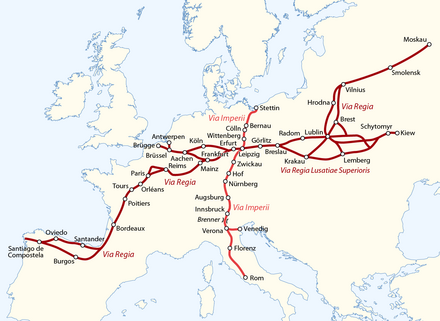
Kiev is a center of attraction for tourism, an economic center and, alongside Lviv and Odessa, the country's cultural center. Kiev is one of the most important traffic hubs in Eastern Europe as the intersection of the traffic routes Istanbul / Athens - Sofia - Kiev - Minsk / Moscow and Western Europe - Caucasus . In addition, Kiev has a river port on the Dnieper , which is bridged by the north bridge and seven other bridges within the urban area.
Road traffic
As the capital, Kiev forms a junction in the Ukrainian road network. The E40 ( Calais / France to Ridder / Kazakhstan ), the E95 ( Saint Petersburg / Russia to Merzifon / Turkey ) and the E101 cross in Kiev . In addition, the trunk roads to Belarus ( M01 ), Russia (via Kharkiv M 03 ), Odessa ( M05 ), Hungary (via Lemberg M06 ), Poland ( M07 ), Znamyanka ( N01 ), Sumy ( N07 ) and Dnipro ( N08 ). In the west, the motorway ring formed by the T –10–27 directs through traffic around the city. Traffic coming from the east crosses the Dnieper in the city and is directed via the N01 on the west side. In addition to a central bus station , Kiev has several bus stations for long-distance bus traffic .
railroad
Numerous international rail connections lead to the main train station ( Kyjiw-Passaschyrskyj ) in Kiev, from Russia, Poland, Hungary, Belarus, Moldova, Austria and Slovakia, among others. Kiev also had access to the Trans-Siberian Railway , which was probably the world's longest railway connection between Kiev and Vladivostok .
Air traffic
Kiev is served by three airports. The smaller and older of the two passenger airports, Kiev-Schuljany , is located in the city and is mainly used by private jets. The company Wizz Air and some Ukrainian charter companies offer domestic and international flights. In Boryspil , about 15 km east of the city limits or 30 km southeast of the city center, there is the larger Kiev-Boryspil Airport (also known as Borispol in Russian spelling), which has significantly more connections and is served by most international lines. The Kiev-Gostomel airport is also an international cargo airport in the northwestern suburb of Hostomel (Russian: Gostomel). The Sviatoshyn Airfield is the factory airfield of the company Antonov .
Inner-city traffic
Inner-city traffic is served by trolleybuses , buses and trams operated by the Kyivpastrans municipal transport company , as well as marshrutkas (minibus line taxes), the S-Bahn and the metro . The latter has three lines crossing the city . In rush hour traffic, the metro runs sometimes every 90 seconds, otherwise every two to four minutes. In the evening it can also be 7-10 minutes, after 11 p.m. up to 12-15 minutes. The metro is closed at night (from around midnight to around 5:45 am). In addition, a funicular (funikuler) connects the Podil district on the Dnieper bank with the city center.
Universities
There are a total of 99 universities. The largest or most important are
- National Taras Shevchenko University (KDU), (* 1834)
- National Technical University "Kiev Polytechnic Institute Ihor Sikorskyj" (KPI), (* 1898)
- National University of Kiev-Mohyla Academy (NaUKMA), (* 1632/1992)
- National Economic University of Kiev (KNEU), (* 1906)
- National Music Academy of Ukraine (NMAU), (* 1913)
- National Academy of Fine Arts and Architecture (НАОМА), (* 1917)
- Kiev National University of Construction and Architecture (KNUCA, formerly KISI), (* 1930)
- National Academy for Aviation and Space Travel (KIIGA), (* 1933)
- Kiev National University of Commerce and Economy (KNUTE), (* 1946)
Sports
The most famous sports club in the city and Ukraine is FC Dynamo Kiev . Other football clubs are Arsenal Kiev and Obolon Kiev , plus the basketball club BK Kiev , the handball club Spartak Kiev and the Ukrainian record ice hockey champions and HK Sokil Kiev . The National Stadium of Ukraine, the Olympic Stadium , is located in Kiev. In August 2007, Kiev hosted the world championships in orienteering . A complete renovation has been carried out since 2008, the stadium was the venue and venue for the final of the 2012 European Football Championship .
From 1968 to 2003 there was a ski jumping hill of category K80 at the national stadium with the Tramplin Olimpijskiy .
Personalities
Famous sons and daughters of Kiev are the writer Mikhail Bulgakov , the film director Maya Deren , the actress Milla Jovovich , the painter Kazimir Malevich , the Israeli Prime Minister Golda Meir and the aviation pioneer Igor Sikorsky .
Other personalities born in the city are included in the list of sons and daughters of the city of Kiev , honorary citizens of the city can be found on the list of honorary citizens of Kiev . The rectors of Kiev University can be found on the list of rectors of Kiev University, and biographies of people clearly related to Kiev are collected in the Person (Kiev) category .
See also
literature
- Britta Wollenweber, Peter Franke: Kiev. City of the golden domes on the Dnejpr. 4th edition, Wostok , Berlin 2008, ISBN 978-3-932916-41-0 .
- Anatoly Kuznetsov: Babiy Yar - the gorge of suffering. Matthes & Seitz, Munich 2001, ISBN 3-88221-295-0 .
- Herbert Mühlstädt: The history teacher tells. Volume 2. 3rd edition. Volk und Wissen volkseigener Verlag, Berlin 1986, pp. 109-133
- Günther Schäfer: Kiev, tours through the metropolis on the Dnepr , 3rd edition, Trescher, Berlin 2011, ISBN 978-3-89794-181-6 .
Web links
Individual evidence
- ^ The State Service of Ukraine for Geodesy, Cartography and Cadastre. (No longer available online.) Archived from the original on August 19, 2014 ; Retrieved July 19, 2019 (Ukrainian).
- ↑ a b Population of Kiev on November 1, 2020 on the website of the Central Statistics Office of Kiev; accessed on December 26, 2020 (Ukrainian)
- ↑ Kiev mother of all cities in Russia? on infranken.de , June 8, 2018; accessed on March 5, 2020
- ↑ About number and composition population of UKRAINE. In: 2001.ukrcensus.gov.ua. Retrieved February 28, 2015 .
- ↑ Первая Всеобщая перепись населения Российской империи 1897 года. In: demoscope.ru. March 21, 2013, accessed February 28, 2015 .
- ↑ 1926 census on demoscope.ru
- ↑ Meyers New Dictionary, Bibl.Inst. Leipzig, 1962. Volume 4, p. 805.
- ↑ 1970 Census of the USSR on webgeo.ru
- ↑ Population figures of Ukrainian cities on pop-stat.mashke.org; accessed on November 24, 2018
- ↑ Department of Statistics of Kiev Population 1995–2019; accessed on May 11, 2019
- ↑ Population of Kiev on November 1, 2020 on the website of the Central Statistics Office of Kiev; accessed on December 26, 2020 (Ukrainian)
- ^ Timothy Snyder: The Reconstruction of Nations. Yale University Press, New Haven 2003, pp. 119-122.
- ↑ All-Ukrainian population census-. In: ukrcensus.gov.ua. September 4, 2013, accessed February 28, 2015 .
- ↑ Стан Громадської Думки Щодо Надання Російській Мові Статусу Другої Державної. (No longer available online.) In: niss.gov.ua. Archived from the original on December 27, 2009 ; accessed on February 28, 2015 . Info: The archive link was inserted automatically and has not yet been checked. Please check the original and archive link according to the instructions and then remove this notice.
- ↑ Russification Via Bilingualism
- ↑ Ukrainian Hydrometeorological Center: Climate Information Kiev. World Meteorological Organization, accessed July 1, 2012 .
- ↑ Andreas Roth: Khazars - The forgotten great empire of the Jews . Pp. 60 and 169 ff. Melzer Verlag, Neu-Isenburg 2006.
- ↑ Neue Zürcher Zeitung ( online )
- ↑ Horst Boog, Jürgen Förster, Joachim Hoffmann , Ernst Klink, Rolf-Dieter Müller , Gerd R. Ueberschär : The attack on the Soviet Union (= Military History Research Office [ed.]: The German Reich and the Second World War . Volume 4 ). 2nd Edition. Deutsche Verlags-Anstalt, Stuttgart 1987, ISBN 3-421-06098-3 , pp. 515 ( limited preview in the google book search - the demolition squads were the engineer battalion 99, parts of the 99th light division and 71st infantry division).
- ↑ Maschke, Erich (ed.): On the history of the German prisoners of war of the Second World War. Verlag Ernst and Werner Gieseking, Bielefeld 1962–1977.
- ↑ Kiev agglomeration. History of the capital's expansion on kievvlast.com.ua from April 24, 2018; accessed on November 23, 2019 (Ukrainian)
- ↑ Crimean crisis: OSCE sends 100 observers to Ukraine. In: Spiegel Online . March 21, 2014, accessed February 28, 2015 .
- ↑ OSCE sends observer mission to Ukraine , RIA Novosti on March 22, 2014.
- ↑ Kiev Agglomeration Association in Kiev founded on vechirniy.kyiv.ua/ on October 9, 2019; accessed on November 23, 2019 (Ukrainian)
- ↑ 19 municipalities founded the Kiev agglomeration on the official portal of Kiev from October 9, 2019; accessed on November 23, 2019 (Ukrainian)
- ↑ The first two cases of coronavirus were registered in Kiev , on rbc-Ukraine from March 16, 2020; accessed on March 29, 2020 (Ukrainian)
- ↑ Coronavirus in Ukraine and the world: What is known on March 16 , on rbc-Ukraine from March 16, 2020; accessed on March 29, 2020 (Ukrainian)
- ↑ The Kiev metro is open on pravda.com.ua from May 25, 2020; accessed on December 27, 2020 (Ukrainian)
- ↑ Vitali Klitschko: 408 patients with coronavirus were found in Kiev last night Official website of the city of Kiev on December 26, 2020; accessed on December 27, 2020 (Ukrainian)
- ↑ Kiev: Saint-Sophia Cathedral and Related Monastic Buildings, Kiev-Pechersk Lavra World Heritage Site on the UNESCO website , accessed on May 14, 2015
- ↑ In Kiev dismantle the monument of one of the initiators of the Holodomor ( Memento of the original from December 3, 2009 in the Internet Archive ) Info: The archive link was automatically inserted and not yet checked. Please check the original and archive link according to the instructions and then remove this notice. . In: Ukraine News of November 25, 2009; Retrieved December 10, 2014.
- ↑ Official website of the Kiev City Council , accessed on June 22, 2014.
- ^ N-tv news television: Third attempt: Klitschko becomes mayor of Kiev - n-tv.de. In: n-tv.de. May 26, 2014, accessed February 28, 2015 .
- ↑ Result of the 1st ballot in the form of October 30, 2015, accessed on January 25, 2016
- ↑ Kiev Mayor Klitschko re-elected , on Interfax November 16, 2015, accessed on January 25, 2016
- ↑ City districts of Kiev on citypopulation.de
- ↑ Міста-побратими. (PDF) Retrieved January 28, 2020 .
- ↑ a b c d e f g h i j k l m n o Новини - Київська міська державна адміністрація. (No longer available online.) Archived from the original on May 27, 2016 ; accessed on January 15, 2017 .
- ↑ Expocenter website (Ukrainian)
- ↑ Website KiewExpoPlaza (Ukrainian)



